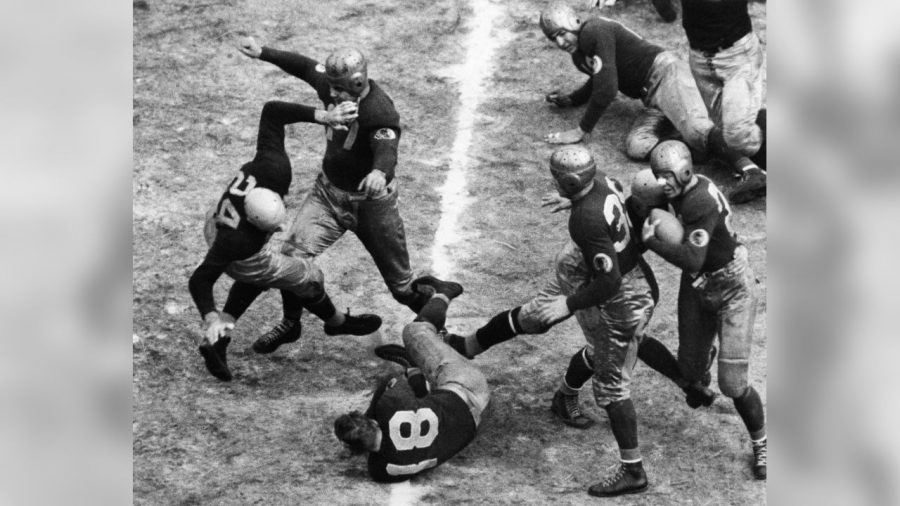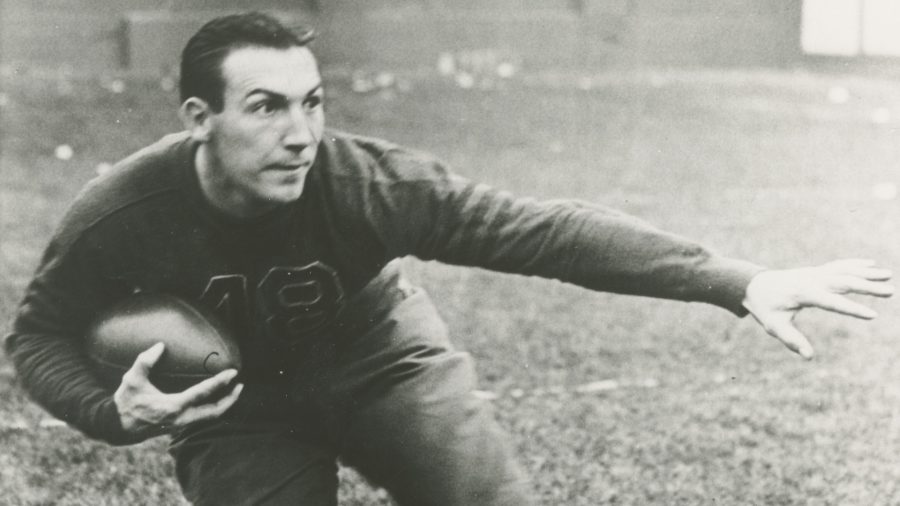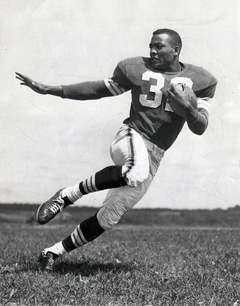THE RUSHING KINGS: FROM 3 YARDS AND A CLOUD OF DUST ONWARDS
By Chris Lawton
We are three weeks into the new NFL season and we have already seen plenty of fun action.
But whenever we are looking forward, that also gets me looking back. Because I love the history of the league.
The NFL celebrated its birthday recently. Having been founded on the 17th of September in 1920 as the American Professional Football Association.
You have to say “NFL” is catchier! But milestones like that always get me thinking about the great history of the game.
And I started thinking about the “3 yards and a cloud of dust” early days of the league emphasising the run.
Who were the first great running backs? Following that train of thought, who was the backs for setting the milestones?
To be clear, I don’t mean every time the rushing yardage record was broken. Rather, each time a milestone was breached. Like the first recorded yardage leader. Or the first time someone ran for 900, 1,000, 1,110 yards season, and so on in the NFL.
1932: THE FIRST RUSHING LEADER
We can never know who the first great rushing leader was. Simply because the NFL did not keep official stats until 1932. However, once they did start keeping records we had our first rushing leader. That man was Cliff Battles of the then Boston Braves (not the Patriots, but rather the team that would settle in Washington from 1937 onwards).
Battles was the rushing leader in 1932 when records were first kept. That season he ran for 576 yards across 8 games.
1932: 148 carries for 576 yards, 3 touchdowns, 3.9 yards per carry.
Battles would only lead the league once again – in 1937 when he ran for 874 yards at 4 yards per carry & won an NFL title with Washington. By the end of his career, he had rushed for 3,511 yards at 4.2 yards per carry & was named a member of the NFL 1930s All-Decade team, and was inducted into the Pro Football Hall of Fame in 1968

1933: A TEAMMATE RAISES THE BAR
While Battles was the rushing leader in 1932, his teammate, Jim Musick really raised the bar one year later. Starting 11 out of 12 games he ran for 809 yards.
1933: 173 carries for 809 yards, 5 touchdowns, 4.7 yards per carry.
So what happened to Musick? It is Battles in the Hall of Fame and Musick is mostly forgotten. That is because his career was effectively foreshortened by a knee injury in 1935. He reinjured it before the 1937 season and never played another down in the NFL.
He might easily have been lost to history if not for that all-star season putting him on this list in 1933.
1934: THE FIRST 1,000 YARD RUSHER
William ‘Beattie’ Feathers is an NFL name beloved of NFL history quiz setters as the first 1,000-yard back. Doing it all the way back in 1934, in one of the most remarkable rushing seasons seen in league history.
1934 was Feathers’ rookie season, and the Bears rookie put on a show that he never matched again.
1934: 119 carries for 1,004 yards, 8 touchdowns, 8.4 yards per carry.
The next highest mark he ever reached was 350 yards. So what happened here? Feathers was definitely a great athlete, having been a back at Tennessee where he ran for 1,800 yards and 32 touchdowns on teams compiling a 25-3-2 record. With the Bears, Feathers ran behind a great line, had Bronco Nagurski as a lead blocker, and crucially, played against some very weak teams in this season. There had been controversy around whether this mark could be real, but no research has ever disproven it, and has come close to finding enough game reports to support it.
This means it stands as the record and we should accept it as such until proven otherwise. Like Musick, Feathers suffered an injury. Feathers got hurt late in the 1934 season and was never the same again. He retired with 1,980 career yards to his name and most of them came in that rookie year. He still did enough overall to be named to the NFL 1930s all-decade team.

1949: THE FIRST 1,100 YARD RUSHER
Steve Van Buren of the Philadephia Eagles had been the first back to breach 1,000 yards since Feathers in 1947 when he ran for 1,008 yards.
Two years later he took the notional single-season all-time crown by rushing for 1,146 yards in a 12-game season.
In fact, van Buren was the league-leading rusher in 1945 (832 yards), 1947 (1,008 yards), 1948 (945 yards), and 1949 (1,146 yards). During that span the Eagles rode Van Buren to three straight NFL title games, losing in 1947 & winning back-to-back titles in 1948 and 1949.
1949: 263 carries for 1,146 yards, 12 touchdowns, 4.4 yards per carry.
After 8 seasons with the Eagles Van Buren retired after the 1951 season having rushed for 5,860 yards at 4.4 yards per carry. He was named to the 1940s All-Decade team and inducted into the Hall of Fame in 1965.
1958: THE GREATEST EVER? JIM BROWN MOVES THE ROCK
Jim Brown is considered one of the best NFL running backs of all time and by many, the best. So it is no surprise to see him make this list. Having run for 949 yards and being named NFL MVP in 1957 as a rookie, Brown exploded to over 1,500 yards and another MVP season in 1958.
1958: 257 carries for 1,527 yards, 17 touchdowns, 5.9 yards per carry.
After such a remarkable season, Brown was held to the lowest total of his career in a playoff replay with the Giants gaining just eight yards rushing on seven carries. But Brown would soon get over that rushing for 1,000 yards 7 times in a 9 season career
1963: BROWN MOVES THE RECORD AGAIN

As said above, Brown had a remarkable, if not legendary NFL career. He saw his career peak in 1963 when he went over 1,800 yards. To this day this is still the Cleveland franchise record. It is currently the oldest franchise record for rushing yards out of all 32 NFL teams.
1963: 291 carries for 1,863 yards, 12 touchdowns, 6.4 yards per carry.
Brown would finish his career with 12,312 yards to his name, at an average of 5.2 yards per carry which is the yardstick for average per carry that all backs with long careers are now measured against.
Brown was named to the 1960s All-decade team, 50th anniversary, 75th anniversary, and 100th anniversary teams as well as being inducted into the Hall of Fame in 1971.
1973: OJ & THE FIRST 2,000 YARD SEASON
In 1973 the Buffalo Bills offensive line was nicknamed ‘the electric company’ because they turned on the juice. Whatever has happened since off the field since, and we cannot ignore that, – OJ was the first to break the 2,000-yard plateau, doing so in a 14-game season.
1973: 332 carries for 2,003 yards, 12 touchdowns, 6.0 yards per carry.
To get to 2,000 yards in 14 games, O.J. had to average 143 yards a game, which is the all-time record. He was named MVP and Offensive Player of the Year. This was Simpson’s 5th season with the Bills. He would be with them for 9 seasons in all before finishing out his career in San Francisco.
Simpson gained 11,236 rushing yards, at 4.7 yards per carry, placing him 2nd on the all-time list at his time of retirement. Simpson was named to the 1970s All-Decade team, 75th-anniversary team, 100th-anniversary team and was elected to the Hall of Fame in 1985.
1984: DICKERSON AND THE RECORD THAT STILL STANDS
Simpson’s record would fall 11 years later in a 16-game season when Eric Dickerson had the most dominant season of his career.
1984: 379 carries for 2,105 yards, 14 touchdowns, 5.6 yards per carry.
Dickerson did not receive either the MVP or Offensive Player of the Year awards this season. This was because Dan Marino stole his thunder by setting a barrage of passing records and winning the individual recognition instead.
Decades later Dickerson remains the NFL single-season rushing leader with this 1984 performance. Bear in mind too that his QB, Jeff Kemp, only threw 13 touchdowns, and no receiver gained 1,000 yards.
This was Dickerson’s second season as a Ram and over those two years, he ran for a remarkable 3,913 yards despite being known to be the team’s primary weapon.
He finished his career with 13,259 yards, 90 touchdowns, and a 4.4 yards per carry average.
Dickerson became the seventh back to gain more than 10,000 yards and was the fastest ever to do so. He was second all-time for yardage when he retired. Ed was named to the 1980s all-decade team, 100th anniversary team, and was elected to the Hall of Fame in 1999.

CHRIS LAWTON
CFL ANALYST
Chris originally started following the NFL with the ‘first wave’ of fans when it was shown on Channel 4 in the 1980’s. He has been a keen supporter of the Miami Dolphins since 1983. Chris first encountered the CFL in 2016 and instantly fell in love with the Canadian game. He has been writing about the CFL 2017. Chris has a degree in history, postgraduate degree in librarianship and can be found on twitter as @CFLfanUK
